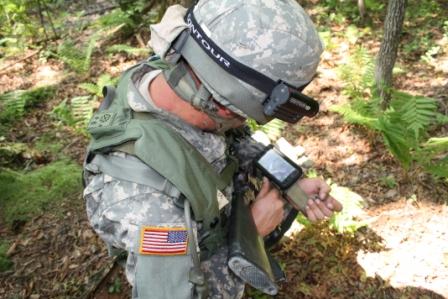
As an Army research, development, and engineering organization, CP&I adds value in innovating and implementing integrated capabilities, whether they are developed internally or by other organizations. The Command and Control aspect of CP&I’s work includes handheld devices for Soldiers. (U.S. Army photo by Edric Thompson, RDECOM CERDEC Public Affairs.
The U.S. Army Research, Development, and Engineering Command’s Communications-Electronics Center (RDECOM CERDEC) has reorganized an element of its workforce to better support integrated capability solutions in mission command; computing platforms; power; and command, control, communications, computers, intelligence, surveillance, and reconnaissance (C4ISR) platform integration.
The CERDEC Command and Control Directorate, or C2D, has changed its name to Command, Power and Integration (CP&I) and has restructured its branches to better emphasize its core competencies and to ensure that those competencies are not split across divisions. The new name directly reflects the organization’s mission, which is to innovate and implement solutions in the specific core competencies of mission command capabilities, mission command computing platforms, power and energy, and C4ISR platform prototyping and integration.
The changes will allow an increased focus on the individual core competencies while also allowing the directorate to better leverage internal synergies to develop integrated capability solutions for Army-unique challenges, said CP&I Director John Willison, a member of the Senior Executive Service.
“We’re doing everything we can to make sure we’ve got the best people with the best facilities working in priority areas in which we can uniquely add value,” Willison said. “Not only will each division have well-defined areas, skill sets, priorities and customers, but we as an organization will be able to connect the dots between these so we’re putting together overall capabilities. This will best posture our organization to add value within each competency and across each competency as a complete package.”
“As an Army science and technology/RD&E organization, we provide value added in both innovating and implementing integrated capabilities, whether the various individual components are ours or those developed by other organizations. We have the expertise to bring all the pieces together to provide integrated capabilities that will solve Army-unique challenges,” Willison said.
Reaction within the directorate has been positive, with personnel recognizing the changes as a more effective path forward, he said.
“We’re catching people on the heels of several significant changes—being relocated as a result of BRAC [Base Realignment and Closure], new leadership, shifting operational priorities, and a current climate of constrained resources across the Army—but this change will help us adapt and put us in a healthier position going forward. We’ll be more uniquely and solidly postured in our various core competencies. In turn, it should be clear to our stakeholders who to go to for what, what our priorities are in each division, and where we think we can add value. This is good for the Army and for the organization,” he said.
- RDECOM CERDEC PUBLIC AFFAIRS







